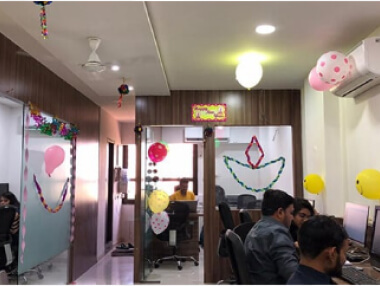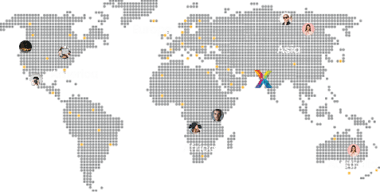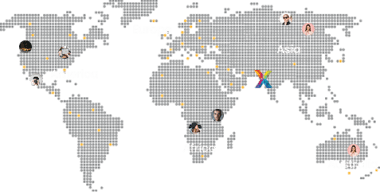As we move further into 2025, the world of WordPress continues to evolve at lightning speed. If you’re running a website, building plugins, or designing themes, now is the time to pay attention. With a market share of over 43% of all websites and more than 61% of the CMS market, WordPress is firmly the platform to watch. In this comprehensive guide from Xceptive Solutions LLP, we’ll explore the key trends that are shaping WordPress development, design, security and business value in 2025 giving you actionable insight to stay ahead of the curve.
1. AI-Powered Editing and Content Generation
Artificial Intelligence (AI) is no longer a buzzword it’s rapidly becoming core to WordPress workflows. More websites are using AI tools for content creation, SEO suggestions, image generation, and layout automation. For instance, recent data shows the top AI-powered WordPress plugins drew over 315 million visits in one year, and usage of AI in design has increased significantly.
What this means for WordPress users You’ll see editors built into WordPress that allow you to generate content drafts, auto-create hero images, or get SEO advice right in the dashboard. You’ll also expect plugins and themes to include built-in AI features rather than bolt-ons.
2. Full Site Editing (FSE) and Block Based Themes
The shift from classic themes to block-based themes and full site editing (FSE) is now mainstream. By 2025, more than 50% of newly built WordPress websites either use the block editor or a hybrid approach.
Benefits include:
- Designers and site owners can edit headers, footers, templates and theme parts via blocks less PHP editing required.
- Theming becomes more modular and faster to evolve.
- Better performance thanks to cleaner code and less bloat from older page builders.
For a WordPress development company like Xceptive Solutions LLP, adopting FSE means faster launches and more maintainable client sites.
3. Headless WordPress and Decoupled Architecture
For sites that require speed, scale, or front-end innovation, headless or decoupled WordPress setups are gaining traction. Using WordPress as the backend while delivering the front end via frameworks like React, Next.js or Vue offers superior performance, mobile engagement, and flexible UX. According to one projection, by 2025 about 20% of new WordPress sites will be built with headless architecture.
Use cases include enterprise portals, PWA (Progressive Web App) experiences, and highly customised storefronts. The key is ensuring your plugin and theme ecosystem supports restful APIs, performance caching, and decoupled workflows.
4. Security & Privacy Take Centre Stage
As WordPress powers more of the web, threats also scale. The majority of hacks still stem from outdated plugins and themes. For example, over 85% of WordPress security incidents are linked to third-party components.
In 2025 you’ll see:
- Zero-trust architecture built into WordPress workflows.
- Blockchain or immutable logs for high-security sites to verify plugin authenticity.
- AI-driven monitoring that can detect suspicious plugin behaviour or site anomalies before they become serious.
- Privacy compliance tools baked into WordPress core and major plugins (GDPR, CCPA, LGPD).
5. Performance & Mobile-First Optimization
With mobile traffic dominating and Google’s Core Web Vitals being essential, performance optimization is non-negotiable. Many WordPress sites now target load times under 2.5 seconds (desktop) and are prioritising mobile rendering.
At the theme and plugin level you’ll observe:
- Lightweight frameworks and minimal dependencies.
- Built-in lazy loading for images and next-gen formats (WebP, AVIF).
- Server-side caching, edge delivery via CDNs, and fewer external calls.
- Block themes optimised to skip unnecessary PHP overhead.
6. Low-Code & No-Code Development Growth
The democratization of site building continues. More non-technical users are launching sites using drag-and-drop builders, block patterns, and theme builders all without touching code. According to trend data, low-code tools and site-builders are becoming a major part of the WordPress ecosystem.
For agencies and developers, this means:
- Shifting focus to custom features and integrations rather than basic site builds.
- Offering premium templates, plugins and patterns tailored to power users.
- Ensuring plugins are builder-friendly and accessible to non-coders.
7. E-Commerce Momentum via WooCommerce and Subscriptions
E-commerce remains one of WordPress’s fastest-growing segments. The WooCommerce plugin powers a significant portion of online stores, and subscription-based models are booming. According to recent data, WooCommerce runs roughly one-third of all online shops.
In 2025 you’ll see:
- More built-in subscription capabilities in themes and plugins.
- Better headless e-commerce integrations with WordPress + front-end frameworks.
- Integration of AI-driven product recommendations and dynamic pricing in WordPress stores.
8. Localization, Multilingual & Global Expansion
WordPress continues to expand globally. Over half of the content across WordPress sites is now non-English.
This trend means:
- Themes and plugins are increasingly multilingual out of the box.
- Region-specific compliance (tax, privacy) becomes standard for global WordPress builds.
- Developers need to ensure RTL, mobile-first, and performance across low-bandwidth regions.
9. Integration with Jamstack, API-First and Micro-Services
The architecture of WordPress sites is evolving. API-first strategies, micro-services, and Jamstack approaches are becoming more prominent. Developers are building WordPress backends connected to headless front ends, static site generation, or micro-services for user management and e-commerce.
This gives you:
- Faster site performance via static generation or edge rendering.
- Greater flexibility for mobile apps, PWA and multi-channel delivery.
- Better security through decoupled front end and backend separation.
Trend 10. Agency Services, Subscription-Based Models & SaaS Plugins
WordPress services themselves are evolving. With over 1.5 million freelancers and agencies offering WordPress services worldwide and a plugin/theme marketplace revenue estimated in the billions, the business model is changing.
What to expect:
- Design-and-build agencies offering subscription-based maintenance, optimization, and headless builds.
- Plugins shifting from one-time purchases to SaaS models (annual licensing, cloud services, integrations).
- More premium-level ecosystems (plugins + hosted services + analytics) bundled into recurring revenue services.
Conclusion
The WordPress landscape in 2025 is about rapid innovation, performance, and flexibility. Whether you run a single site, manage multiple client builds, or develop plugins and themes, aligning with these trends will keep you competitive and efficient.
At Xceptive Solutions LLP, we specialise in cutting-edge WordPress services from custom plugin and theme development to headless integrations, performance optimisation, and ongoing maintenance. Let’s talk about how we can future-proof your WordPress ecosystem.
Frequently Asked Questions (FAQs)
Will WordPress still be relevant in 2025 and beyond?
Yes — WordPress holds over 43% of all websites and continues to grow its ecosystem. :contentReference[oaicite:16]{index=16}
What is Full Site Editing (FSE)?
FSE is the capability to edit all parts of a theme (header, footer, templates) using blocks rather than writing PHP or modifying theme files directly.
What is headless WordPress?
It means using WordPress as a backend CMS while delivering front-end through frameworks like React or Next.js — ideal for performance and modern apps.
How is AI changing WordPress websites?
AI is being used for content generation, image creation, UX suggestions, SEO, and even full website builds through chat interfaces. :contentReference[oaicite:17]{index=17}
What should I prioritise for WordPress site performance?
Focus on mobile-first design, lightweight themes/plugins, lazy loading, caching, and monitoring Core Web Vitals.
Are low-code/no-code tools impacting developers?
Yes — these tools allow non-technical users to build sites quickly, so developers must shift toward custom solutions, integrations and value-added services.
How important is security for WordPress in 2025?
Very important — many security breaches stem from outdated plugins. Zero-trust and AI-driven monitoring are key future strategies. :contentReference[oaicite:18]{index=18}
Is WordPress good for international/multilingual websites?
Absolutely — multilingual usage is growing and themes/plugins are increasingly designed for global reach. :contentReference[oaicite:19]{index=19}
What business models are emerging around WordPress?
Subscription-based services, SaaS plugins, recurring revenue maintenance plans and headless builds are now the norm. :contentReference[oaicite:20]{index=20}
How can I make sure my WordPress site is future-proof?
Choose technologies aligned with the trends above, keep code and themes updated, invest in performance and security, and partner with an expert like Xceptive Solutions LLP.



